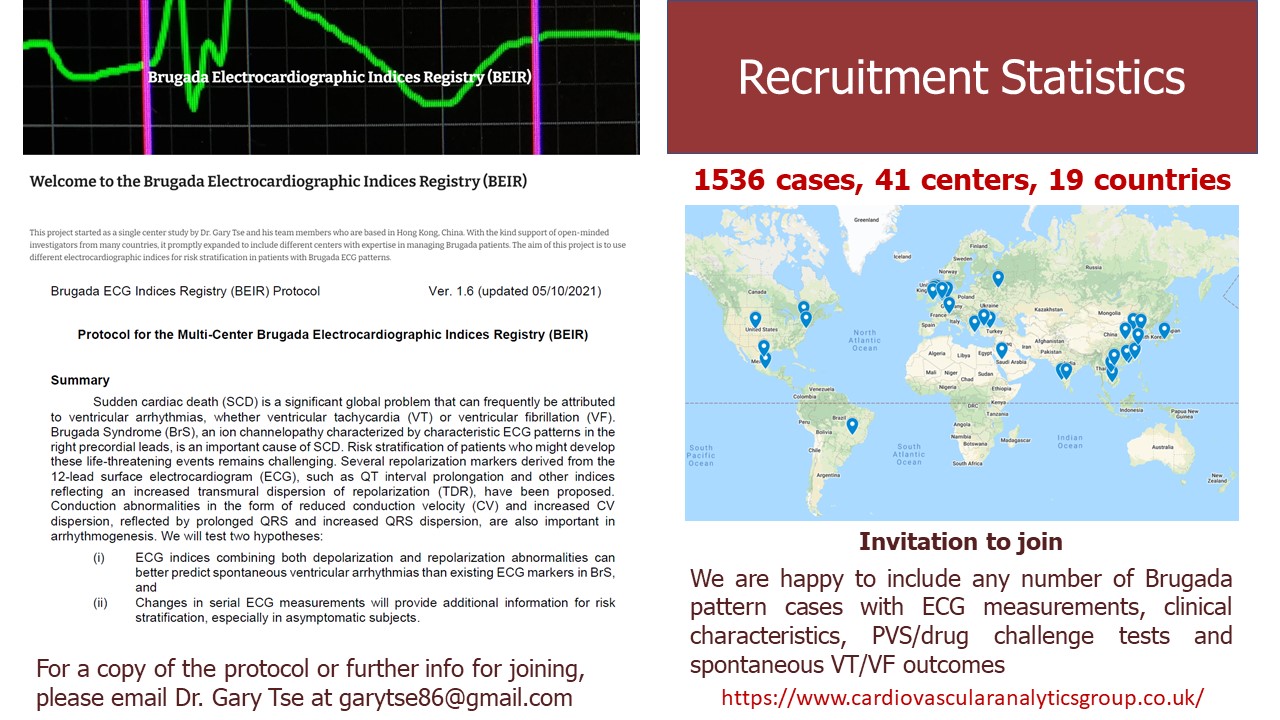Opportunities
Collaborations
Invitation to join the International Brugada Electrocardiographic Indices Registry (BEIR) Study
We are recruiting cases with either Brugada pattern or Brugada syndrome, with clinical and ECG details. A large number of cases is not needed, we are accepting any patient who fulfills the criteria of having Brugada pattern on the ECG. If you are interested in joining and would like a copy of the protocol, please get in touch with the study coordinator Dr. Gary Tse at garytse86@gmail.com

Positions
Assistant/Associate Professor in Image Analysis
The University of Utah is seeking to hire an outstanding tenure-track faculty member in image analysis at the Assistant or Associate Professor level. The position is a joint effort between the Scientific Computing and Imaging (SCI) Institute and the College of Engineering (COE) with one of the departments in the COE serving as the tenure home. Ideal candidates might have backgrounds in scientific computing, biomedical engineering, electrical and computer engineering, or related fields.
The SCI Institute has established itself as an internationally recognized leader in visualization, scientific computing, and image analysis applied to a broad range of application domains. The College of Engineering and its departments (Biomedical, Chemical, Civil, Electrical, Materials Science, and Mechanical Engineering) form an exciting set of programs with a strong emphasis on interdisciplinary science and engineering and collaborative approaches to research and education. The University of Utah is located in Salt Lake City, the hub of a large metropolitan area with excellent transportation connections, a high level of affordable and livable communities, and rich cultural and recreational opportunities. Additional information about our research, education, and current SCI faculty can be found at http://www.sci.utah.edu.
PhD Student Position “Efficient discretization methods for the microscale bidomain model”
The Center for Computational Medicine in Cardiology (CCMC), Università della Svizzera italiana, is seeking a highly motivated PhD student to develop innovative numerical discretization strategies to robustly solve on exascale HPC systems the cell-by-cell bidomain model of cardiac electrophysiology at subcellular scale. A strong background in numerical analysis and computational science is requested.
The MICROCARD project
The PhD student will join the EuroHPC MICROCARD consortium, a multi-disciplinary and international team with the ambitious goal of simulating a cell-by-cell electrophysiology model of the heart at organ-scale. The PhD student will benefit from the opportunity to work and collaborate with leading experts in the field of cardiac modeling, large-scale numerical simulations, deep learning, and high-performance computing (HPC) systems. Further information is available on the project website www.microcard.eu.
Institutional environment
The position is funded by the Center for Computational Medicine in Cardiology (CCMC). The CCMC, headed by Professors Rolf Krause and Angelo Auricchio, brings advanced numerical methods in multiscale modeling, uncertainty quantification and artificial intelligence to the needs of clinical practitioners. Built upon the multi-disciplinary competences brought by its founder members at the Euler Institute and Cardiocentro Ticino, the CCMC is unique of its kind in Switzerland and is a key member of the large EU projects like MICROCARD.
Your challenges
- To understand the mathematical and numerical difficulties associated with the cell-by-cell bidomain model.
- To identify criticalities in standard spatial discretization approaches that shall be addressed to ensure a good balance between of accuracy and scalability.
- To work in synergy with other scientists from the MICROCARD consortium in the definition of optimal time integration approaches, preconditioners, and task-based parallel implementation.
- To understand the physiological background the model and compare it the classical homogenized bidomain model, also in terms of numerical solution.
- To attend and to present your research activity at international conferences.
- To publish your findings in international, peer-reviewed journals.
- To assist in teaching activities of the Euler Institute.
- To actively contribute and collaborate within the MICROCARD consortium for the success of the project.
Your profile
- You have a strong background in applied mathematics.
- You have a strong interest in numerical analysis and HPC.
- You have experience in computational science with programming environments (C, C++, Python) and HPC computing (MPI, OpenMP, CUDA).
- You hold a master’s degree in applied mathematics or computational science.
- Some experience in cardiac modeling is welcome but not strictly necessary.
We offer a 3-year PhD position in a multidisciplinary, international and inspiring environment. The position is full-time and salary in accordance to regulations of Università della Svizzera italiana.
The position should be finalized by September 2021.
For further information, please don’t hesitate to contact Dr. Simone Pezzuto (simone.pezzuto@usi.ch).
How to apply
Interested candidates must send their application documents (cover letter, CV, description of research interests and experience, names of at least two academic references), preferably as single PDF file, to Prof. Rolf Krause (rolf.krause@usi.ch) and Dr. Simone Pezzuto (simone.pezzuto@usi.ch).

